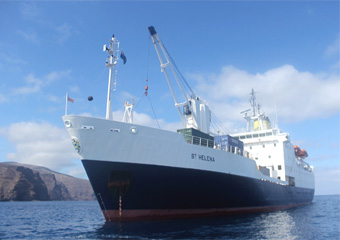By Kevin Hughes
Gleaming in Cape Town’s morning sun, white with a yellow stack and dark blue from just below the main deck to the waterline, the RMS St Helena was British — very British — with a British captain and officers and “saints,” as the St. Helenans are called. That was in the 80s and 90s. Today the entire ship is crewed by St. Helenans, right up to, and including, the captain.

Following the tradition of the Union-Castle Line, which carried passengers and cargo between the U.K. and Cape Town from 1901 to 1977, the RMS maintains the same tradition from the deck games to the elegant lunch and dinner service, even the jingle announcing meals and a “beef tea” service on the sun deck at 10am every morning. One purser used to even play “Rule, Britannia!” every time the ship left a British island—a bit of colonial bravado no longer practiced by the “saints.” It’s a fairly small ship, with a maximum capacity of 128 passengers, 1,800 tons of cargo, and 56 officers and crew.
Idyllic is probably the best word to describe the unique, historic island of St. Helena lying 3347 km from Cape Town — almost a five-day sail — and about 1300 km off the nearest coast of Africa. Cutoff from the rest of the world, it is a step back in time; a good place to relax and contemplate the vagaries and vicissitudes of life. The population of about 700 “saints” is an ethnically and racially diverse mix, many being the descendants of sailors or soldiers who served on St. Helena or whose ships passed through.
It is a delightful world of “ones”— one bank, one post office, one hotel (the Consulate), one police station/jail (almost never needed) and one outdoor café. There are also a few guesthouses, several tiny shops, a pub or two (counting the bar at the Consulate Hotel), and a small museum.
Sights include: Longwood House, where Napoleon spent his last years; his tomb (his remains have long since been repatriated to Paris); Plantation House (the governor’s residence and home to Jonathan the tortoise, the island’s oldest inhabitant), and the Jacob’s Ladder (a torturous staircase of 699 steps, built in 1829, leading from Jamestown to a small fort on top of one of the hills facing the town.) It’s a gorgeous, interesting place.
Enter the “outside world” of government and bureaucrats. A hair-brained scheme to build an airport on St. Helena, eliminating the need for the RMS, was concocted in London and misguidedly funded and built. As had been predicted, it is a treacherous place to land, akin to landing on an aircraft carrier, with a persistent crosswind, and severe wind shear as air rushes over the top of the island and nearby higher terrain. With pilots unwilling to land there, the airport is now closed and the RMS St Helena’s schedule has, thankfully, been extended at least until July 2017.
For information on the RMS St Helena contact: www.rms-st-helena.com



